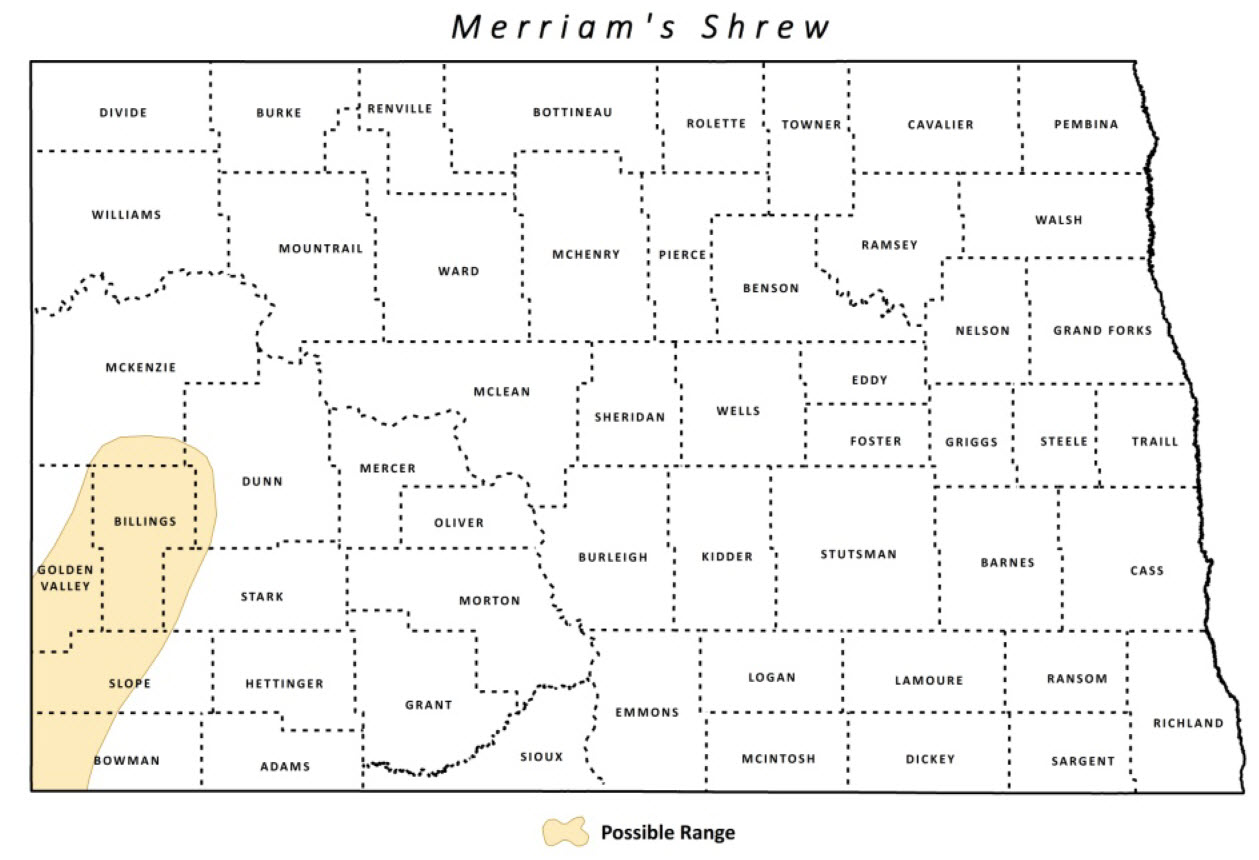
Merriam's Shrew
| Scientific Name | Sorex merriami |
|---|---|
| General Description | A medium sized shrew approximately 4 inches in total length. Pelage gray above with a lighter buff or white underside. |
| Status | Resident. |
| Abundance | Rare. |
| Primary Habitat | Found in dry shortgrass prairie or sage steppe habitats. |
| Federal Status | No federal status. |
| Reason for Designation | Rare to North Dakota. Maybe on the fringe of its range but recent surveys may be showing some range expansion. |
Locations and Conditions of Key Habitat
Preferred Habitat
Currently it has been documented in extreme western North Dakota. Its preference for arid grasslands and sage-steppe habitat would make it possible in counties on the western and southwestern edge of North Dakota. Literature shows an association with sage-brush vole populations although it has not been documented in North Dakota.
Key Areas and Conditions for Merriam's Shrew in North Dakota
Merriam’s Shrews have been documented in Billings and McKenzie counties in the state. Recent records have come from Black-tailed Prairie Dog colonies. This may show a potential preference for this species. Also literature shows an association with sage-brush vole populations although it has not been documented in North Dakota.
Problems Which May Affect this Species
Habitat
Loss of native mixed grass prairie and sage-steppe habitat.
Other Natural or Manmade Factors
Loss and fragmentation of habitat due to energy development. Over-grazing of mixed grass and sage-steppe habitat.
Research and Survey Efforts
Current Research or Surveys
- Northeastern State University is currently surveying “fringe” mammals in southwestern ND of which the Merriam’s Shrew is included.
Previous Research or Surveys
- Northern Prairie Wildlife Research Center has developed an annotated bibliography for mammals of North Dakota
- University of North Dakota Climate Change and Land use Effects on Small Mammal Communities in a Northern Great Plans Landscape.
Additional Research or Surveys Needed
- Research and survey efforts are needed to identify target areas and possible threats for this species.
- Develop a monitoring protocol for small mammals.
Management Recommendations
- Work with partners to implement easements or land acquisition.
- Work with the oil industry to minimize impacts to grassland habitats.
- Implement restoration projects where possible.
- Implement grazing systems to benefit shortgrass prairie residual cover, forb species, and woody draws.
- Control noxious weeds through biological and chemical methods.
- Work with oil industry to minimize impacts to short-grass habitats.
- Look to exchange and consolidate mineral rights, particularly within focus areas.
- Continue to provide public land management agencies with mitigation recommendations in respect to species of concern.
- Survey areas of data gaps. Conduct research/surveys to establish baseline information on SCP.
Monitoring Plans
No monitoring plan for this species has been developed.
2005-2015 Progress
The Merriam’s Shrew was added as a Level III Species of Conservation Priority in the 2015 revision of the Wildlife Action Plan. Individuals documented in the recent Black-tailed Prairie Dog survey (SWG T-32-R) were only 2nd and 3rd recorded for the state. SWG T39-R Survey of “Fringe Mammals” will investigate this species status in the state further.

Note: A listing of works consulted when compiling the information on this page may be found in the 2015 State Wildlife Action Plan.
